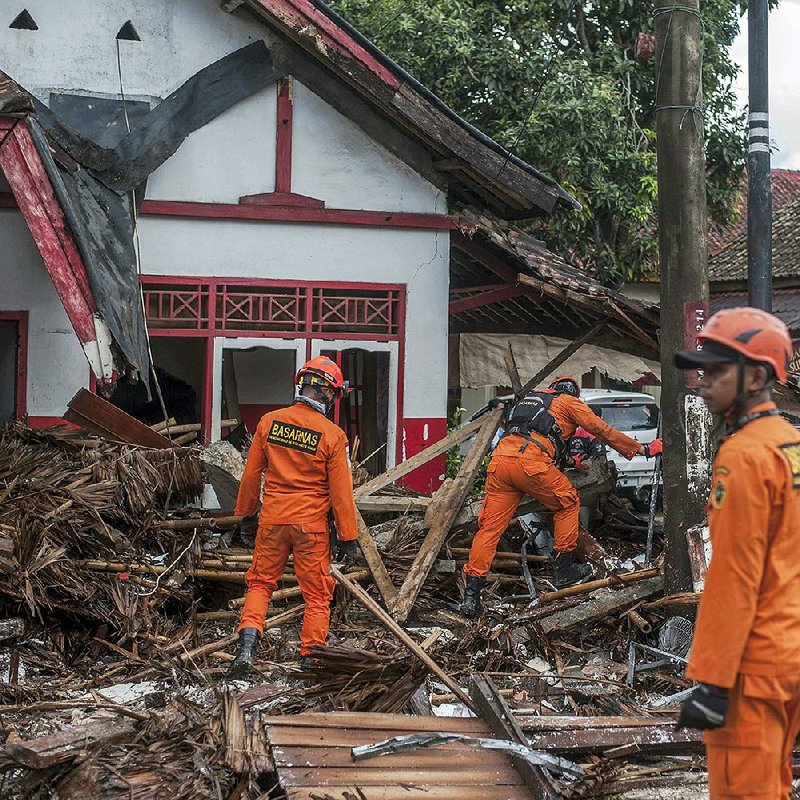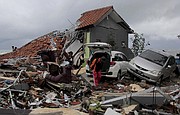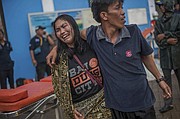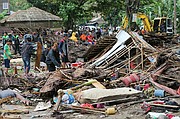CARITA BEACH, Indonesia -- Doctors worked to help survivors and hundreds of people searched beaches early today for more victims from a deadly Saturday night tsunami that smashed into houses, hotels and other buildings without warning along Indonesia's Sunda Strait.
At least 281 people were killed and more than 1,000 were injured. Dozens of others were reported missing after the tsunami hit coastal areas along western Java and southern Sumatra islands at 9:27 p.m. local time Saturday, according to Sutopo Purwo Nugroho, spokesman for the Disaster Management Agency. The death toll could increase once authorities hear from all stricken areas.
The Indonesian Medical Association of Banten region said it is sending more doctors and medical equipment and that many of the injured are in need of orthopedic and neurosurgery expertise. It said most patients are domestic tourists who were visiting the beach during the long holiday weekend.
The disaster came about a half-hour after an eruption and possible landslide on Anak Krakatau, one of the world's most infamous volcanic islands. It was the second deadly tsunami to hit Indonesia this year, but the one that hit the island of Sulawesi on Sept. 28 was accompanied by a powerful earthquake that gave residents a brief warning before the waves struck.
The area hit hardest was the Pandeglang region of Java's Banten province, which encompasses Ujung Kulon National Park and popular beaches, including Tanjung Lesung Beach. The area is popular with visitors from Jakarta, the capital, especially during the Christmas holiday weekend.
Videos and photos from Pandeglang showed extensive damage, with houses crushed and at least one car overturned.
One video showed a police officer rescuing a boy, 5, from a damaged home in Banten.
In a video posted on Twitter by Sutopo, search-and-rescue workers are shown pulling two bodies from rubble.
Officials said the road from Pandeglang to the nearby regency of Serang had been cut off, hampering rescue efforts. Dozens were also killed across the Sunda Strait in Sumatra.
About 600 buildings were damaged, officials said.
"People are still afraid to go back to their homes since there were still rumors that a tsunami might strike again," said Aulia Arriani, a spokesman for the Indonesian Red Cross.
Indonesian President Joko "Jokowi" Widodo expressed his sympathy and ordered government agencies to respond quickly to the disaster.
"My deep condolences to the victims in Banten and Lumpung provinces," he said. "Hopefully, those who are left have patience."
At the Vatican, Pope Francis prayed for the dead, the missing and the homeless in Indonesia, telling tourists and pilgrims in St. Peter's Square that his thoughts were with victims "struck by violent natural calamities."
U.S. President Donald Trump tweeted support for Indonesia: "We are praying for recovery and healing. America is with you!"
The U.S. State Department also expressed its support: "Our thoughts and prayers are with all those in Indonesia affected by the natural disaster. We are currently not aware of any U.S. citizens directly affected, but stand ready to assist as needed."
'I CRIED IN FEAR'
Azki Kurniawan, 16, said his first warning about the tsunami was when people burst into the lobby of the Patra Comfort Hotel shouting, "Seawater rising!"
Kurniawan, who was undergoing vocational training with a group of 30 other students, said he was confused because he had not felt a big earthquake. He said he ran to the parking lot to try to reach his motorbike but discovered it was already flooded.
"Suddenly, a [3.3-foot] wave hit me," he said, his eyes red and swollen from crying. "I was thrown into the fence of a building about [100 feet] from the beach and held onto the fence as strong as I could, trying to resist the water, which felt like it would drag me back into the sea. I cried in fear ... 'This is a tsunami?' I was afraid I would die."
In the city of Bandar Lampung on Sumatra, hundreds of residents took refuge at the governor's office, while at the popular resort area of Anyer beach on Java, some survivors wandered in the debris.
Tourists who were enjoying the long holiday weekend ahead of Christmas were also affected.
"I had to run, as the wave passed the beach and landed [50-65 feet] inland," said Oystein Lund Andersen, a Norwegian, in a Facebook post. The self-described photographer and volcano enthusiast said he was taking pictures of the volcano when he suddenly saw the water racing toward him.
He rescued his sleeping wife and child from a nearby hotel, and they fled safely to higher ground.
He paid tribute to residents of the local community of Anyer, who he said were "opening their doors to the people who have evacuated."
On Sunday, Andersen posted an update, saying he was in a car headed to Jakarta and praised the Indonesian government for "doing a great job dealing with the situation on the ground."
The damage became apparent after daybreak Sunday. Nine hotels and hundreds of homes were heavily damaged by the waves. Broken chunks of concrete and splintered sticks of wood littered hard-hit coastal areas, turning beach getaways popular with Jakarta residents into near ghost towns. Vehicles were tossed into the rubble or were buried under collapsed roofs. Debris from thatch-bamboo shacks was strewn along beaches.
Yellow, orange and black body bags were laid out, and weeping relatives identified the dead.
CAUGHT OFF GUARD
The Anak Krakatau volcano has been rumbling for months, spewing columns of superheated ash and ribbons of lava that hiss into the currents between Indonesia's most populated islands.
A report on the website of the Global Volcanism Program, an arm of the Smithsonian Institution, said that Anak Krakatau produced ash plumes that reached 200 and 300 feet on Dec. 14 and Dec. 18, respectively. It said that "residents were warned to remain outside the [1.24-mile] radius zone from the crater."
Indonesian authorities are always on alert for tsunamis after any seismic activity in one of the world's most quake-prone regions. But this one caught everyone off guard.
Tsunamis are created when large amounts of water -- in the ocean, a bay or even a lake -- are quickly displaced. In an earthquake, that displacement can occur when the ground moves as a fault breaks.
But without the earthquake, no tsunami alerts were raised. There was no big temblor to even get the warning system in motion as the wall of coffee-colored water raced toward the shore, where it ripped buildings from their foundations in seconds and swept terrified visitors on a popular resort beach into the sea.
The initial speculation by experts, including Indonesia's Meteorology and Geophysics agency, was that the tsunami could have been caused by landslides on the steep slope of the erupting volcano. The scientists also cited an unusually high tide because of the full moon.
"My suspicion is that there was an landslide under the sea. Perhaps a trench crumbled," Igan Sutawijaya, a volcano and geological disaster expert, said in a phone interview. "It doesn't make sense that it was caused by the eruption of the Krakatau."
Sutopo Purwo Nugroho, spokesman for Indonesia's disaster agency, also said the preliminary theory was that the tsunami was caused by "an undersea landslide resulting from volcanic activity on Anak Krakatau."
"Data collection is still ongoing. It's likely that the number of victims and damages will rise," said Nugroho.
David Applegate, the associate director for natural hazards at the U.S. Geological Survey, said in a telephone interview Sunday that the tsunami was unusual because it was not among the 90 percent caused by an earthquake.
"This is probably the ultimate no-notice event," he said.
While it is clear that there wasn't a large earthquake triggering the tsunami, a definitive cause is not yet known but will likely be determined in the next day or so, Applegate said.
"The only question is whether it is related to volcanic activity," he said.
Gegar Prasetya, co-founder of the Tsunami Research Center Indonesia, said Saturday's tsunami was likely caused by a flank collapse -- when a big section of a volcano's slope gives way. It's possible for an eruption to trigger a landslide above ground or beneath the ocean. Both are capable of producing waves, he said.
Volcano-related tsunamis are not uncommon. An eruption in 1792 in Japan created waves that were several hundred feet high. Landslides during the 1980 eruption of Mount St. Helens in Washington spawned large waves in a lake nearby.
The largest wave ever recorded was caused by a landslide into Lituya Bay, in southeast Alaska, in July 1958. It followed an earthquake, not an eruption, but created a wave that wiped vegetation off the hillside on the opposite side of the bay.
A U.S. Geological Survey geologist, measuring the scouring marks, determined that the height of the 1958 wave had been more than 1,700 feet.
Prasetya said the wave created Saturday was not nearly so large.
"Actually, the tsunami was not really big, only [about 3.3 feet]," said Prasetya, who has studied Krakatoa. "The problem is people always tend to build everything close to the shoreline."
'CHILD OF KRAKATOA'
The 1,000-foot-high Anak Krakatau, whose name means "Child of Krakatoa," lies on an island in the Sunda Strait between Java and Sumatra islands, linking the Indian Ocean and the Java Sea. It has been erupting since June and did so again about 24 minutes before the tsunami, the geophysics agency said.
The volcanic island formed over the years after the 1883 eruption of the Krakatoa volcano, one of the largest, most devastating eruptions in recorded history. That disaster killed more than 30,000 people, launched far-reaching tsunamis and created so much ash that day was turned to night in the area and a global temperature drop was recorded.
Krakatoa was obliterated in the eruption. Most of the island sank into a volcanic crater under the sea, and the area remained calm until the 1920s, when Anak Krakatau began to rise from the site. It continues to grow each year and erupts periodically, although it is much smaller than Krakatoa.
Volcanic activity creates a tsunami differently. One possibility is an explosive eruption, or general weakening of the flanks of a volcano by hot magma passing through. Either way, part of the volcano -- perhaps, in the case of Anak Krakatau, a part that is underwater -- can collapse, displacing water.
Another possible mechanism is the collapse of a magma chamber below the volcano as it empties during an eruption.
Indonesia, a 3,000-mile-wide archipelago of more than 17,000 islands that is home to 260 million people, lies along the "Ring of Fire," an arc of around 120 active volcanoes and fault lines in the Pacific Basin. Roads and infrastructure are poor in many areas of the country, making access difficult in the best of conditions.
The disaster is the latest in a string of calamities this year in Indonesia.
In September, more than 2,500 people were killed in an earthquake and tsunami that hit Sulawesi, an island 1,000 miles northeast of Jakarta.
In July and August, Bali and Lombok, islands popular with tourists, were struck by earthquakes that together killed more than 500 people.
In late October, a Lion Air passenger plane crashed after takeoff from Jakarta, killing all 189 people aboard.
The death toll from disasters in Indonesia this year is the worst since 2005, when a 6.3-magnitude earthquake struck the city of Yogyakarta on Java island, killing more than 5,000 people.
Saturday's tsunami also rekindled memories of the magnitude-9.1 earthquake that hit Indonesia on Dec. 26, 2004. It spawned a giant tsunami off Sumatra island, killing more than 230,000 people in a dozen countries -- the majority in Indonesia.
Information for this article was contributed by Niniek Karmini, Margie Mason and Ali Kotarumalos of The Associated Press; by Stanley Widianto, Gerry Shih, Brian Murphy and Michael Kranish of The Washington Post; by Henry Fountain, Muktita Suhartono and Richard C. Paddock of The New York Times; and by Simon Roughneen and Shashank Bengali of the Los Angeles Times.
A Section on 12/24/2018



